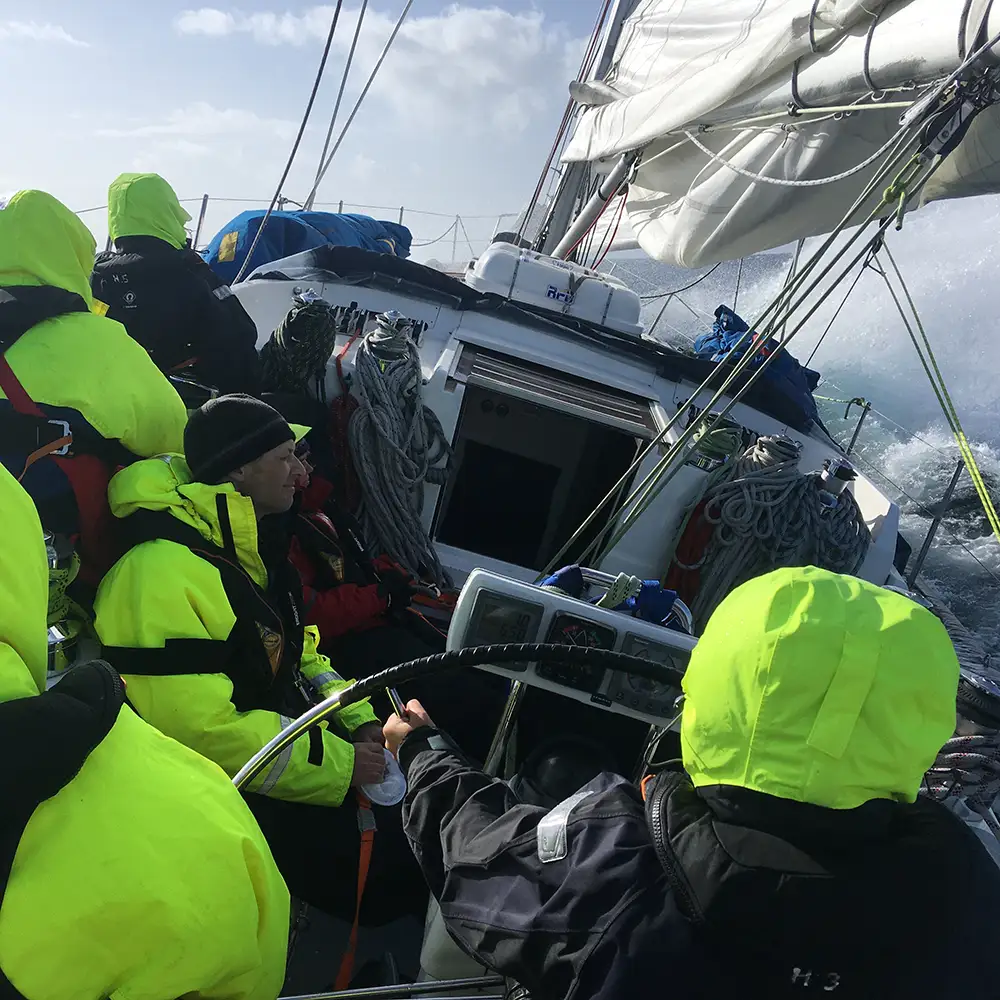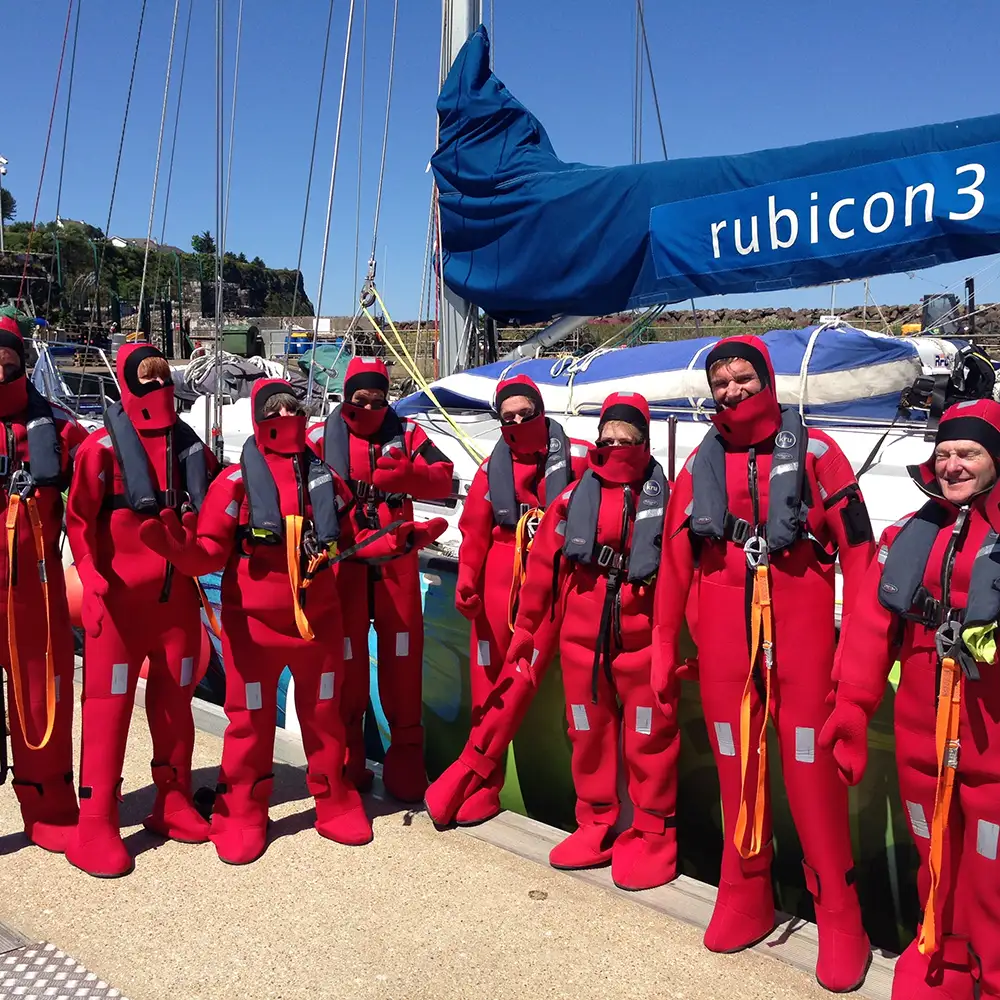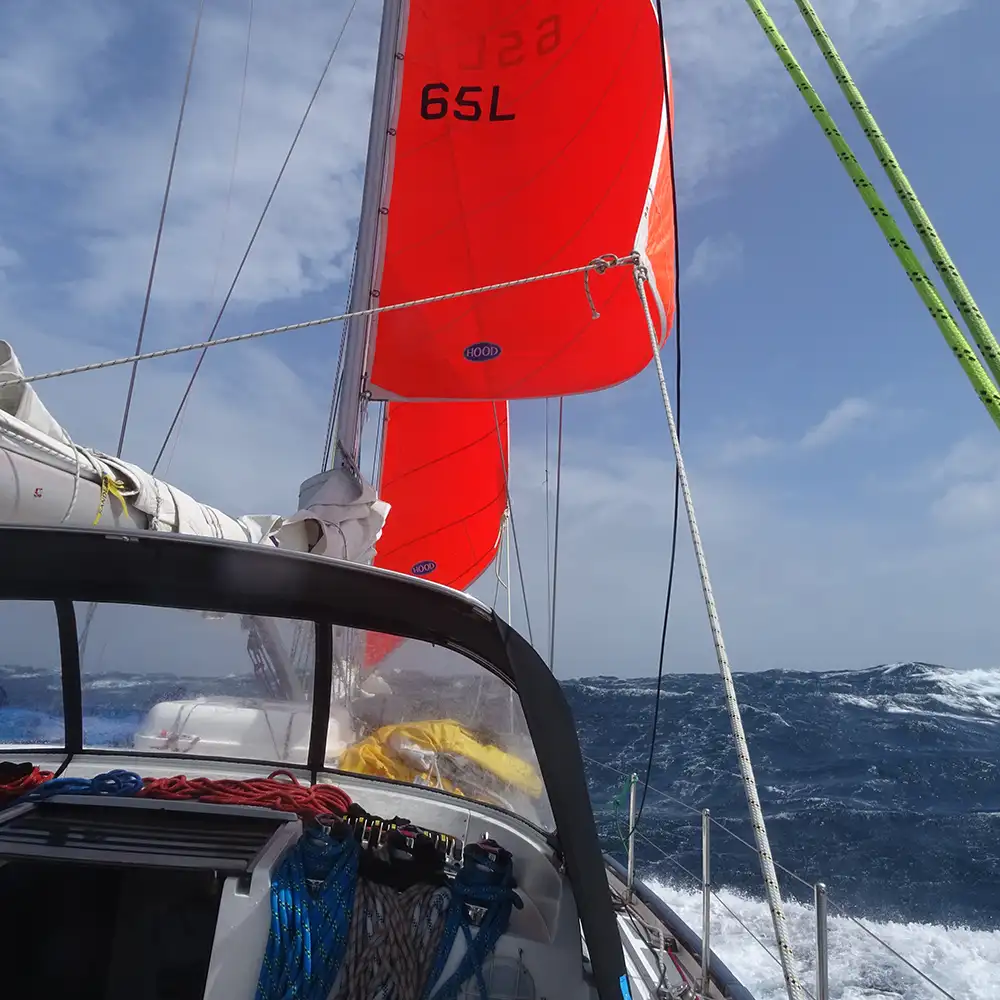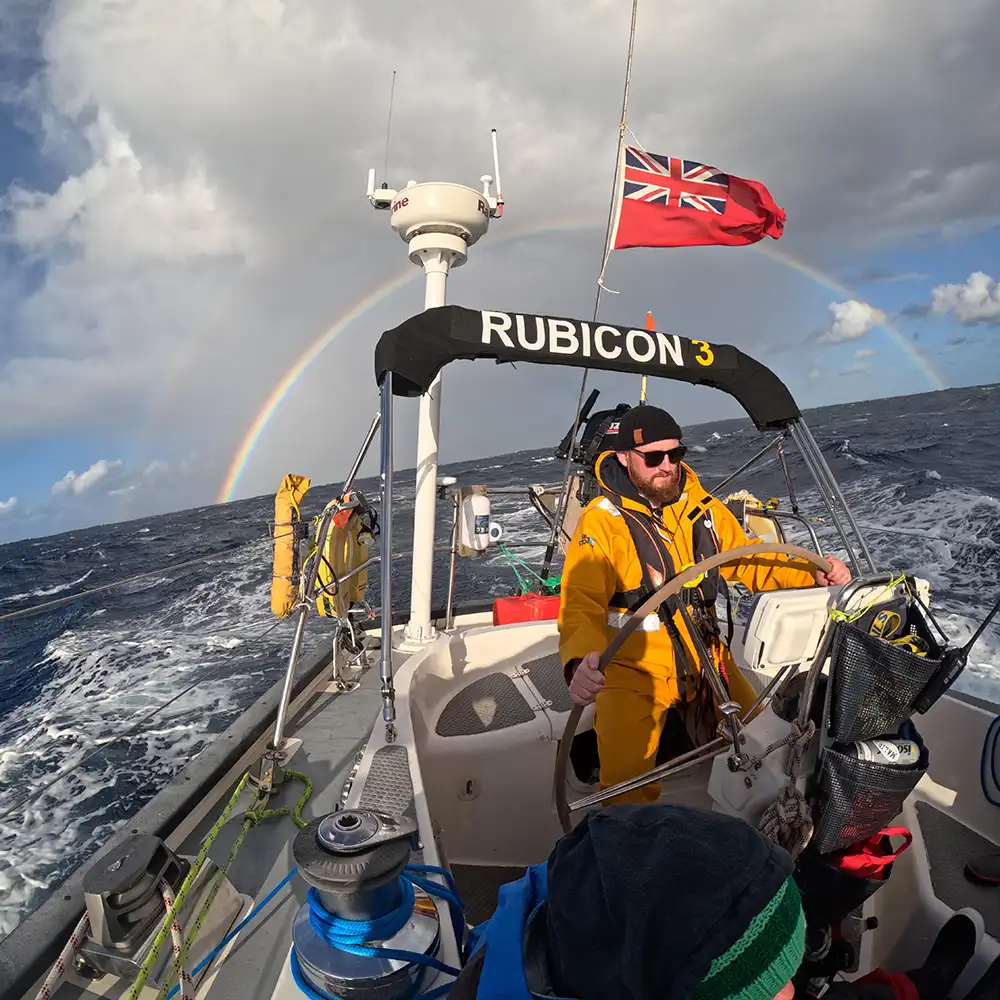As the wind strength increases and the sea state builds, what was a fun, exhilarating sail can quickly become a real challenge. Big waves suddenly hit the boat, the wind is screaming through the rigging, and every bit of equipment is under tremendous physical strain. The wind or the waves want to rip it from the boat and break it in half. The boat is pitching, yawing, and slamming on waves; even the most straightforward movements and tasks become a real challenge. It is a narrow ledge, and one only needs to start sliding off it rapidly to be in survival conditions. A sail comes loose or tears; a halyard snaps; a hatch comes loose, and the boat starts flooding, you’re suddenly being blown onto a lee shore…

Anyone who has experienced heavy weather sailing will surely know what it is like when things start to go wrong – and it is not easy to recover. This may be accompanied by rising anxiety and, quite possibly, seasickness, and this is when severe accidents and injuries can occur. Heavy weather is something that many a sailor, including Ocean Yachtmasters, may never have encountered. Over the next few months, we will look at many aspects of heavy weather, including tactics for using sails such as a storm jib or trysail. Today, however, we are starting with a simple overview of what heavy weather is for sailors. In future weeks, we will look at heavy weather sailing techniques and storm tactics, how and when to heave to, when to use a drag device such as a sea anchor and drogues, and looking at essential safety equipment such as an EPIRB.
What is heavy weather?
The perennial question of what is heavy weather has no set answer. Heavy sailing weather is simply conditions you find challenging or consider potentially dangerous sea conditions. This will be characterized by strong winds and/or rough seas. Still, the specific criteria for what constitutes heavy weather will vary considerably depending on the type of vessel, the experience of the crew, and geographical location. What is horrible weather for recreational sailors on a Contessa 32, using a small storm sail and near rocks may be barely a blow for a professional crew running an 80′ Oyster out in the Atlantic Ocean. For most, though, the following characteristics give a fair definition:
High Winds
The Beaufort scale, developed by Sir Francis Beaufort in 1805, is a standardized system to estimate wind strength based on observed sea conditions. It is the scale on which all sailing forecasts are based. It ranges from 0 to 12, starting at “Calm” with a smooth sea surface and no wind, to “Hurricane” with devastating wind speeds over 64 knots and exceptionally high waves, often over 45 feet. Although Force 6 (22-27 knots and 10-foot waves) is called the yachtsman’s gale, for most of us, it is when we encounter winds of Beaufort scale force 7 (30-34knots) and above that we begin to think ‘heavy weather.’
The direction we are sailing in relation to the wind is also crucial due to the apparent wind. This is the wind experienced on the yacht. It differs from the true wind, which is the wind one would feel if stationary, as it is the result of the true wind combined with the wind created by the boat’s motion. The apparent wind is crucial for sailors because it determines the experienced weather and the wind’s angle for sail trim. Gusts don’t just increase wind speed; they also bring the apparent wind forward (if sailing upwind). Calculating apparent wind is not a simple matter, relying as it does on vector mathematics, but if one visualizes a parabellum, where one line is true wind speed, and the other is boat speed, a line drawn to the far corner will give an excellent indication of apparent wind speed and direction.

So for example, 30 knots of breeze, 50° off the bow, will give an apparent wind speed of 35 knots and just 40° off the bow. In sailing terms, that is the difference between a fast, manageable reach and plowing slowly into headwinds. Should the true wind gust 40 knots, the apparent wind will be 44 knots and another 3° further forward. Unless she is a performance cruiser, she will be all but stopped in her tracks.
Now let’s turn the yacht around and head 180° the other direction. Assuming boat speed stays the same for comparison purposes, suddenly, the 30 knots true wind becomes 26 knots apparent, and the apparent wind angle is 118°: a beautiful flat, fast, broad reach. That 40-knot gust only feels like 36 knots and takes the apparent wind even further back to more like 120°.
As sailors will know, the difference between pounding upwind, close hauled in 35 knots (gale force winds), possibly down to storm sails, and sailing downwind on a broad reach in 26 knots is the difference between night and day. One is heavy weather; the other is exhilarating with fast boat speed as the boat accelerates down a wave (the time you can easily surpass theoretical maximum hull speed) … and no pounding.
Sea state
The sea state, rather than the wind, often poses the greatest danger to cruising boats. While wind speeds are the cause, the resulting sea conditions – the size, frequency, and direction of waves – directly impact most boats’ safety and maneuverability. High winds and a long fetch can generate steep waves and swell, creating hazardous conditions where yachts risk broaching, knockdown, or pitchpoling. Additionally, cross seas, where waves come from different directions, can lead to unpredictable and rough sailing conditions, increasing the risk of damage and injury. Short, steep waves are particularly dangerous as their impact can exert immense force on the yacht’s structure.
What sailors fear most is breaking waves, especially so in most modern boats that have much lower stability than those of past generations. A breaking wave is one whose height exceeds its limits of vertical stability, causing the crest to spill over and collapse into the trough of the wave. It can happen as water depth decreases (look at a beach) or when the wind forces the top of the wave to move faster than the bottom is able to. Breaking waves are full of kinetic energy, with their height increasing gravitational forces and the process of the ‘break’ releasing further compressed energy in the molecules. The resulting release of energy, force, and direction can cause loss of control, structural damage, and water ingress. They are a major danger in areas where the depth suddenly shoals, such as the continental shelf in the Bay of Biscay.
We discuss storm tactics in breaking seas in a future article, but the rule of thumb is that a breaking wave is dangerous to a yacht when its height is at least 30% of the boat’s LOA and when it hits on or near the beam.

Visibility
Visibility is critical in heavy weather due to its direct impact on our ability to assess and respond to changing conditions and potential hazards.
- Navigation and Obstacle Avoidance: Good visibility is essential for identifying navigational markers, other vessels, and potential hazards such as rocks or floating debris. 30 knots of breeze in clear blue skies is one thing and may be quite manageable. The same wind in heavy rain, sea spray, and dark clouds make it far more challenging and can significantly increase the risk of accidents, collisions, or running aground. It is all too easy with bad visibility to run out of sea room and have the wind rapidly blow you into danger.
- Crew Coordination and Safety: Visibility affects the crew’s ability to communicate and coordinate. In fog, at night, and in driving rain, the risk of accidents on deck increases dramatically, and communication suffers. Man overboard incidents also become far more dangerous due to the difficulty of spotting and recovering a person in the water.
Visibility Definitions:
- Unrestricted Visibility: The ability to see clearly to the horizon, typically over 10 nautical miles.
- Moderate Visibility: Sufficient visibility for safe navigation but with some limitations, usually ranging from 2 to 10 nautical miles.
- Restricted Visibility: Significantly impaired visibility, often less than 2 nautical miles, requiring reduced speeds and heightened caution.
- Fog: A specific weather condition where visibility is reduced to less than 1 nautical mile due to water droplets suspended in the air.

So, what is heavy weather?
In conclusion, heavy weather is a changeable concept which encompasses not just high winds but also the accompanying rough seas, reduced visibility, and the potential for rapid changes in conditions. It is whatever that boat or crew experiences as heavy weather, accepting that what challenges the skill and competencies of one crew and vessel may be quite different for another. Many people ask us to take them out into heavy weather, but we would never casually or unnecessarily do so. One has to have immense respect for nature’s power and a high level of seamanship. By preparing for and respecting the sea, sailors can learn to navigate confidently and responsibly through even the most challenging seas. Articles on heavy weather tactics, (including when to see common sense and start motor sailing!) skills, and equipment for how to do that are all to come.